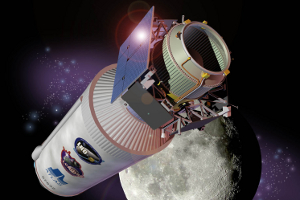“It’s water and much more,” said Anthony Colaprete, an astrophysicist at NASA Ames Research Center in Mountain View. “The others, from a scientific standpoint and a resource standpoint may prove to be as important or more important.”
Colaprete is the principal investigator on the mission to find water on the moon, which is known as LCROSS or the Lunar Crater Observation and Sensing Satellite. Last year, the scientists shot an unmanned spacecraft from Cape Canaveral, Florida, and in October, they deliberately crashed its rocket at 6,000 mph into Cabeus, a cold, dark crater on the moon’s south pole that hasn’t seen sunlight in billions of years.
The impact sent up a plume of lunar soil and debris several miles over the crater’s rim, exposing it to sunlight. Meanwhile, the spacecraft collected data for four crucial minutes, allowing scientists to analyze the chemical makeup of the ejected lunar soil, before it too crashed into the crater. In the nine months since then, the LCROSS team has been sifting through the information to glean clues about earth’s 4.5 billion year-old neighbor.
How wet is the moon?
“As wet as the Sahara, perhaps wetter in some places”, said Colaprete.
On Tuesday, at the third annual Lunar Science Forum at NASA Ames, researchers discussed everything from the physics of the LCROSS impact to the complex chemistry of the moon. Among their findings:
- The distribution of water on the moon is not uniform, but “chunky”, occurring in deposits in dark craters like the one LCROSS struck.
- The range of chemicals found on the moon is wider than once thought and includes mercury, magnesium, sulfur dioxide and possibly, formaldehyde, along with sodium, hydrogen sulfide, carbon dioxide and methane.
- The total amount of water in the target site and the plume observed by LCROSS: 26 gallons
So how did the water get there? According to Colaprete, it’s likely a combination of sources. One way it could have arrived is from solar wind depositing hydrogen into the lunar granules which contain oxygen atoms. Another way is from impacts by icy comets slamming into the moon, a theory supported by the observation of these other chemicals and hydrocarbons that also exist in comets.
The last manned lunar mission was Apollo 17 in 1972. In recent years, the U.S., along with Japan, China and India have launched various unmanned lunar mission. NASA is scheduled to launch two other lunar exploratory missions, GRAIL and LADEE in 2011 and 2012, respectively, to map the moon’s interior structure and further analyze the moon’s dust.
Sometime in the next several decades, a new generation of astronauts may return to set up a lunar outpost, setting the stage for future missions to Mars.
“In the next 20 years, next 10 years, you’re going to see the moon continue to expand in its diversity, and its complexity and its interest, among the communities of both laypeople and professionals and that’s going to pull us there,” said Colaprete. “There’s a lot you can do with the moon. It’s fundamental to understanding our place in the solar system and we’ve always appreciated that and recent studies have accentuated it.”
37.52119957659491 -122.0086669921875
 Artist's rendering of the LCROSS spacecraft and its upper stage Centaur rocket. Image courtesy of NASA.
Artist's rendering of the LCROSS spacecraft and its upper stage Centaur rocket. Image courtesy of NASA.